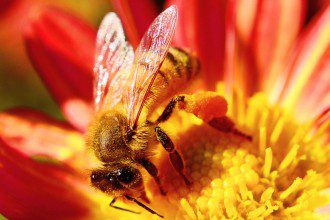Contributing Writer for Wake Up World
By now most of us are aware that the humble bee is not only responsible for creating one of the most natural, health giving, and divinely sweet substances — honey — but also for managing one of the most vital steps in the production of our food crops — pollination. Unfortunately what has contributed to this newfound awareness about bees and the crucial role they play in our food chain, and by extension, their relevance to our survival as a species, is their rapid and initially mysterious decline.
According to the US Department of Agriculture, bees (wild and farmed) play a key role in the production of about 1/3 of all the food we eat, and add 15 billion dollars to the annual value of the country’s food crops. Because the animals we consume are generally fed fodder that comes from crops dependent on honey-bee fertilization, and since even plant based fibres like cotton rely on bees for pollination, the implications are massive.
A recent study led by Insu Koh at the University of Vermont in the US, was the first national study to map the decline of wild bee communities in the US. The findings were published December 21 in the Proceedings of the National Academy of Sciences.
[pro_ad_display_adzone id=”110028″]
The research team estimate that wild bee communities declined by 23% between 2008 and 2013 in the US. The study also demonstrated that 39% of US croplands that rely on bees for pollination face an ominous mismatch between rising demand for pollination and a falling population of wild bees.
“Until this study, we didn’t have a national mapped picture about the status of wild bees and their impacts on pollination,” says Koh the lead researcher in this study. This is a vital piece of the puzzle considering that each year more than $3 billion of the US agricultural economy relies on the services of wild pollinators.
“It’s clear that pollinators are in trouble,” says Taylor Ricketts, the senior author on the study. “But what’s been less clear is where they are in the most trouble — and where their decline will have the most consequence for farms and food.”
“Now we have a map of the hotspots,” contributes Koh. “It’s the first spatial portrait of pollinator status and impacts in the U.S.” This ‘portrait’ could become an invaluable tool in assisting to protect wild bees and for identifying appropriate habitat restoration efforts.
What is particularly interesting is that while pesticides and fungicides have now been irrefutably implicated in the decline of the bees, this study shows that their decline may also be influenced by the conversion of bee habitat into cropland. In eleven states with the most alarming levels of decline there has been a huge increase (200% in five years) in grasslands and pastures converted to corn fields. “These results reinforce recent evidence that increased demand for corn in bio-fuel production has intensified threats to natural habitats in corn-growing regions,” the new study notes.
“When sufficient habitat exists, wild bees are already contributing the majority of pollination for some crops. Even around managed pollinators, wild bees complement pollination in ways that can increase crop yields,” says Neal Williams, a co-author on the study from the University of California, Davis.
“We can now predict which areas are suffering the biggest declines of wild bee abundance,” Insu Koh says, “and identify those areas, with low bee supply and high bee demand, that are the top priority for conservation.”
Homogenization
The study noted that many of the hotspots for bee decline are in areas that had recently been converted to corn for the production of bio-fuel. What is particularly disturbing about this trend is that a majority, if not all of this corn, is likely to come from genetically modified seed stocks, which are heavily used in US agriculture. This means that not only is there no diversity in terms of the types of plants growing in these areas, but there is no genetic diversity among their numbers either.
Our modern world, based on a scientific and economic framework has been heading swiftly down a road towards a regimented, homogenized, and standardized approach to farming (and unfortunately many other areas as well). A desire for maximum yields and efficient, consistent production directs us logically towards extensive mono-crops, genetic engineering and the use of pesticides and fertilisers. This regimented, Hegelian mentality is spreading like a cold-hearted disease and slowly absorbing our beautiful rich and varied landscape. Bees, who have been described as symbols of love, sweet abundance and creativity are likely the canary in the coal mine, warning us of the profound dangers of our current approach to land management.
“Human beings have fabricated the illusion that in the 21st century they have the technological prowess to be independent of nature. Bees underline the reality that we are more, not less, dependent on nature’s services in a world of close to 7 billion people”
~ Achim Steiner, Executive Director UN Environment Programme (UNEP)
Diversity
It appears that diversity is more important for our survival than corporate interests would like to admit. While homogenization might make for good business practice in terms of efficiency, it seems that nature’s preference for diversity might represent a more evolved and healthy approach; one that benefits the planet as a whole, rather than the pockets of few. Just as any human whose diet was based on any one ingredient alone would likely suffer negative health consequences, it is not really surprising that a bee who is deprived of access to diversity in terms of food-source will also suffer. Diversity contributes to creative richness and robustness on both a physical and psychological level.
Solutions: Bee The Change
Researchers at Harvard Micro-robotics Lab believe they may have developed a solution to this problem: mechanical bees. These tiny robotic bees, made of titanium and plastic, would be immune to problems facing real bees (ie man-made toxins and homogenous diets) and could potentially replace our little black and yellow friends. However, this ‘solution’ follows the same type of logic that got us into this mess and fosters an increasingly artificial reality. As Albert Einstein once said, “we can not solve our problems with the same level of thinking that created them”.
It seems clear to an increasing number of us that we need to radically change our direction as a species to one that prioritizes the planet and its inhabitants, rather than profit. Hopefully as science catches up with what seems obvious at a heart level, we will see a move towards aware and creative, rather than emotionless and mercenary solutions to our problems.
“Mindfulness is not the path of chasing. It is the path of beautification. When flowers blossom, the fragrance spreads, and the bees come.”
~ Amit Ray Ph.D, Mindfulness: Living in the Moment, Living in the Breath
In the meantime we can all do a little bit to help by buying organic, and ensuring that whatever land we have the ability to manage is free from the chemicals and poisons that threaten our amazing little pollinating associates. By transforming our green spaces into sanctuaries of beauty, color and scent, we will not only ensure that there is diversity in terms of the plants bees depend on as a food source, but that we too have access to healthy, uplifting environments. Water is also important. An open vessel filled with stones or marbles and water (to the level of the stones) provides a safe way for bees to access water without the risk of drowning.
“… tiny striped martyrs then bravely depart
From the plant, at some length, to the swarm.
The nectar collected, their personal art.
The hive waiting, welcome and warm.To witness this magic in calm disbelief,
Is a treasure, a blessing to see.
The simple, whole truth is, from mountain to reef,
All life here would cease without bees.”~ Mandi June, An Ode To The Bee
Sources:
- www.eurekalert.org/pub_releases/2015-12/uov-wbd121715.php
- www.businessinsider.com.au/harvard-robobees-closer-to-pollinating-crops-2014-6
- www.economist.com/blogs/economist-explains/2015/09/economist-explains-2
Previous articles by Christina Lavers:
- New Study Shows Regular Contact with Nature Reduces Crime, Increases Social Cohesion
- Research Shows Just 7 Minutes of Meditation Can Reduce Racial Prejudice
- Groundbreaking Study Maps the Decline of Wild Bee Communities in the United States
- More Evidence That TV is Dumbing Us Down
- Taking Care of Our Inner Tribes – Microflora, Awakening and You
- Taking Responsibility For Our Energy
- Discernment – Navigating The Spiritual Minefield
- TV: Cutting the Cord
- Heart Aligned Eating: Beyond Dietary Absolutes
- The Art Of Failing Well
About the author:
Christina Lavers is a writer, an artist, a creative enthusiast, and an inner world explorer. Born in Montreal Quebec Canada, she now lives with her life partner and son in a rainforest pocket in the hills behind Coffs Harbour, NSW Australia. She spends her time playing, creating, growing and sharing.
Christina is devoted to assisting people to find and connect with their own creative magical current that flows deep within. She is now offering a comprehensive e-course designed to help people light up their world with passion and creativity. You can access Section One here for free!
Christina has also recently published her first full length book, a memoir about her wild awakening journey entitled Jump Into the Blue, and she is currently working on the next one.
“My journey has been about personal alchemy… exploring the mysteries of my soul and my environment, and learning to bring all aspects, the light and the dark, together with the transcending ingredient… love. The more I uncover and nurture the wounded aspects of my being, the more whole and grounded I feel and the more my outer world reflects the love, wonder and magic I have discovered inside”.
You can follow Christina’s work at:
[pro_ad_display_adzone id=”110027″]








